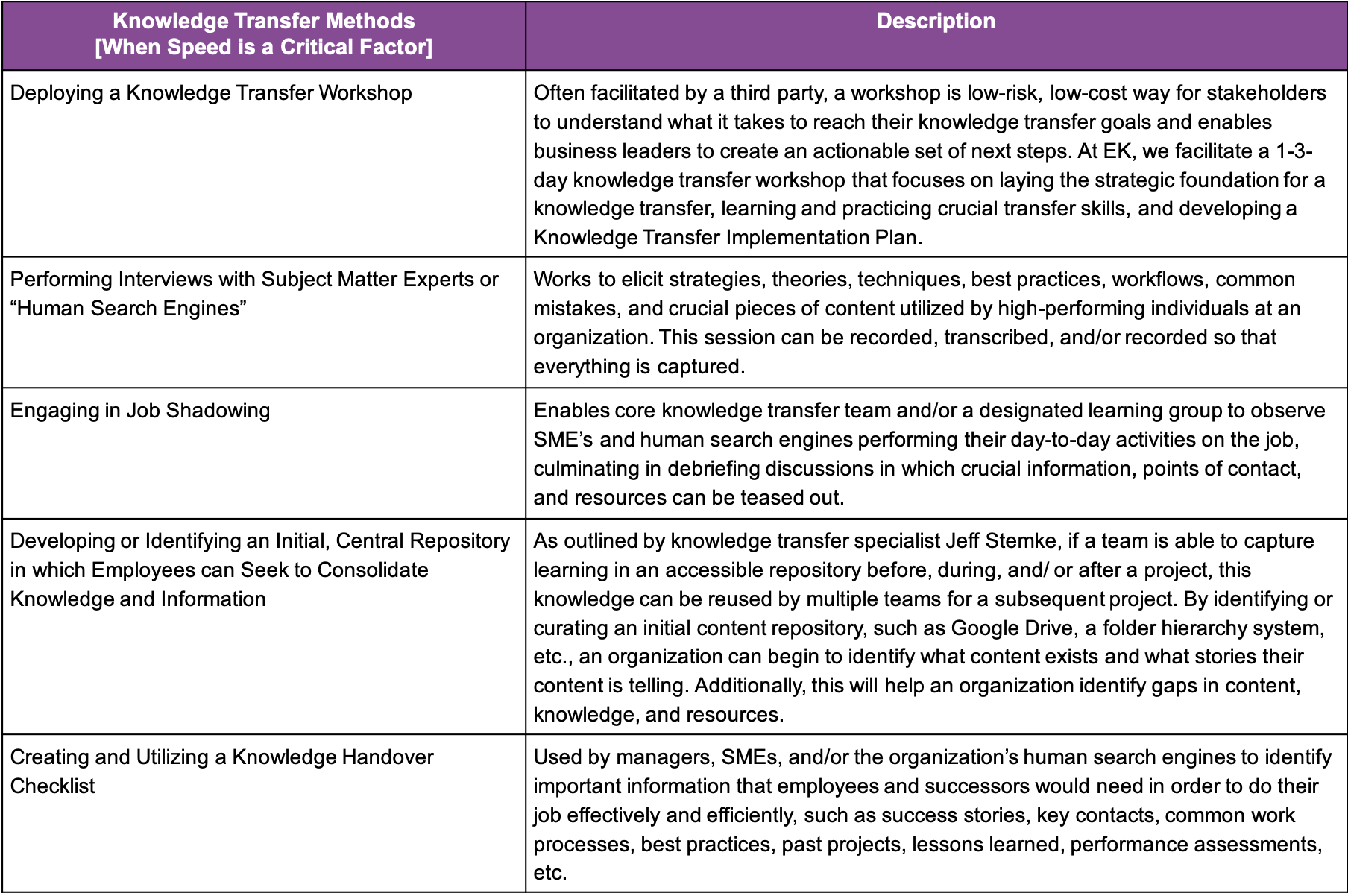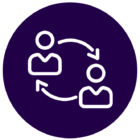All too often, organizations do not recognize the need and value of knowledge management efforts until a knowledge-related crisis occurs. Perhaps a top-level executive has chosen to leave the organization and has not documented the knowledge and experiences that they have garnered over the course of their career; or maybe an organization has experienced rapid growth and is struggling to impart the necessary knowledge and skills new hires need to succeed. Whatever the case, knowledge management practices are often not implemented until they are desperately needed by an organization. Ultimately, this push for knowledge management during a time of change or chaos tends to manifest into a burning need for a knowledge transfer, or the act of organizing, creating, capturing, and sharing an organization’s valued content, such as the expertise and tacit knowledge of its key professionals, with other members of the organization.
Whatever the case, knowledge management practices are often not implemented until they are desperately needed by an organization. Ultimately, this push for knowledge management during a time of change or chaos tends to manifest into a burning need for a knowledge transfer, or the act of organizing, creating, capturing, and sharing an organization’s valued content, such as the expertise and tacit knowledge of its key professionals, with other members of the organization.
As I will discuss in my next blog, the best way to ensure that the “know-how” of your organization is captured and disseminated effectively is to build and sustain a culture of knowledge sharing. A knowledge sharing culture enables knowledge transfers to occur frequently and instinctively by people across an organization, avoiding the need for formalized transfers at the point when information is at risk of being lost. Having said this, if your organization is at a crisis point and needs an immediate solution to its knowledge management challenges, then the best starting point is to implement the most crucial components of a knowledge transfer. Below, I share my top five tips for a successful knowledge transfer during times of chaos, crisis, or rapid change.

TIP #1: ENCOURAGE EMPLOYEE BUY-IN AND HAVE LEADERSHIP SET THE TONE.
When a knowledge transfer effort is not delivered with the proper messaging, it is easy for employees to view the process as creating additional work, rather than creating value. This is particularly true when sharing knowledge is viewed as relinquishing one’s power or expertise within an organization, in other words, “If I am not the primary holder of this knowledge, then I will not receive recognition or rewards.”
For this reason, it is vital that leaders of an organization provide their employees with context about a knowledge transfer and keep them feeling included in the process. This involves openly sharing the processes that will occur throughout the engagement, conveying short-term and long-term goals, identifying required resources and tools, and making it clear that leaders are also contributing to and investing in the effort. For example, EK previously worked with a client’s leadership team to develop a communications plan that outlined how they would introduce and continuously communicate the steps and level of effort involved in accomplishing their knowledge transfer goals. This involved EK facilitating a workshop for the client’s core team members that demonstrated the need and value of a knowledge transfer and concluded in the development of a consensus-driven roadmap that denoted major action items, timelines, and team involvement. Ultimately, the key is to unite the members of the organization and show their efforts and knowledge as contributing to a mutually beneficial end-goal.
Similar to how my colleague suggests employing gamification to ensure effective change management, outlining the benefits that can be earned by individuals that contribute to the knowledge transfer will also create an incentive that enables the transfer to gain momentum. This might involve offering monetary rewards, such as bonuses or cash prizes, for those that contribute to the knowledge transfer effort or ensuring that those who share information are adequately recognized and praised for doing so. By making it clear that those who are sharing and transferring knowledge will be compensated in a meaningful way, your knowledge transfer will be better prepared to receive the level of effort and engagement that it requires.

TIP #2: IDENTIFY WHO IN YOUR ORGANIZATION KNOWS WHAT KNOWLEDGE IS MOST VALUABLE.
Not all knowledge is created equal. The task of identifying what knowledge is most valuable for employees, whether it is tacit or explicit, is crucial for a knowledge transfer as it allows for knowledge to be both recognized and prioritized. For many, this task can feel daunting, particularly if your organization possesses large quantities of information and lacks well-defined repositories that make knowledge findable and discoverable for users.
The best place to begin is to discover and work with your organization’s “human search engines,” or those individuals who are frequently asked questions by fellow employees about how to best do their jobs. These are the experts of your organization who will have the best insight into what knowledge will be necessary to capture throughout the knowledge transfer. Ask them questions, such as “What are the daily needs of our knowledge consumers?” and “What is the information that an employee at a particular level or in a specific sector needs to be successful in their job?” These conversations will enable you to gain a holistic view of the organization and identify what knowledge is being utilized by particular groups of employees.
 TIP #3: IDENTIFY THE APPROPRIATE KNOWLEDGE TRANSFER METHOD FOR YOUR ORGANIZATION.
TIP #3: IDENTIFY THE APPROPRIATE KNOWLEDGE TRANSFER METHOD FOR YOUR ORGANIZATION.
There is no one-size-fits all solution for those seeking to complete a knowledge transfer. Factors like an organization’s culture, size, industry, available technology (such as collaboration platforms), knowledge repositories, and employee buy-in all play a role in determining which knowledge transfer method will best suit your organization’s needs. Some of the most common methods for undergoing a knowledge transfer include:

When selecting which method or combination of methods is best for your organization, seek to answer the following questions:
- How quickly does this knowledge transfer need to occur? Do we have days, weeks, or months?
- How many experts should be involved in the process? How long are these experts available/how much time can they commit to this endeavor?
- What is the depth or complexity of the knowledge that needs to be transferred? Is the knowledge technical, difficult to understand/convey, or multi-faceted?
- What is the ability for experts to articulate their knowledge?
By being aware of the effort level and complexity of your knowledge transfer, you will be able to best select which method(s) will be most effective for capturing, managing, and disseminating your organization’s crucial knowledge. In truth, there is often no single approach that meet an organization’s knowledge transfer needs, so at EK, we often construct a strategy that leverages a combination of these and other approaches in order to ensure that comprehensive, natural knowledge transfer is occurring.
 TIP #4: RECOGNIZE WHEN TO CALL IN A THIRD PARTY OR ENLIST ADDITIONAL RESOURCES.
TIP #4: RECOGNIZE WHEN TO CALL IN A THIRD PARTY OR ENLIST ADDITIONAL RESOURCES.
Recently, Enterprise Knowledge partnered with a client facing a major knowledge dilemma.Having chosen to terminate one of their primary office locations in an effort to downsize, “Client X” was confronted with the reality that they had not captured any of the knowledge possessed by employees who were planning to leave the organization. Faced with losing expert-level knowledge and experience, “Client X” attempted to engage in a speedy knowledge transfer, only to find that they lacked the resources and employee buy-in necessary to make progress. As a result, “Client X” turned to Enterprise Knowledge to help them understand how they could ensure that the knowledge that was so critical to their organization was not lost and could be leveraged by current and future employees.
If tensions are running high, resources are lacking, or there is insignificant buy-in from members of your organization, it is often best to bring in a third party to facilitate your knowledge transfer. By bringing in experts from outside of your organization, you are not only ensuring that knowledge transfer best practices are being employed but are increasing the overall legitimacy and perceived importance of the knowledge transfer.
 TIP #5: USE THE INSIGHTS AND EXPERIENCE GAINED FROM THIS RAPID KNOWLEDGE TRANSFER TO LAY THE FOUNDATION FOR INCREASED, CONTINUED KNOWLEDGE SHARING WITHIN YOUR ORGANIZATION.
TIP #5: USE THE INSIGHTS AND EXPERIENCE GAINED FROM THIS RAPID KNOWLEDGE TRANSFER TO LAY THE FOUNDATION FOR INCREASED, CONTINUED KNOWLEDGE SHARING WITHIN YOUR ORGANIZATION.
Don’t let a rapid knowledge transfer in a time of chaos or crisis be the end of your organization’s knowledge transfer journey. Forbes estimates that poor knowledge-sharing practices cost Fortune 500 companies $31.5 billion annually and that effective knowledge management increases company productivity by up to 40%. The best knowledge transfers aren’t those that occur at the point of crisis, but are those that are naturally ingrained in an organization. At Enterprise Knowledge, we are adept at helping organizations, both in the short- and long-term, achieve successful knowledge transfers and build a culture rooted in knowledge sharing so that their employees have access to the right information at the right time.
Interested in completing a successful knowledge transfer for your organization or beginning the process of developing a knowledge sharing culture? Contact us at info@enterprise-knowledge.com for more information.
